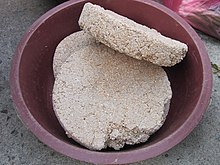

A fermentation starter (called simply starter within the corresponding context, sometimes called a mother[1]) is a preparation to assist the beginning of the fermentation process in preparation of various foods and alcoholic drinks. Food groups where they are used include breads, especially sourdough bread, and cheese. A starter culture is a microbiological culture which actually performs fermentation. These starters usually consist of a cultivation medium, such as grains, seeds, or nutrient liquids that have been well colonized by the microorganisms used for the fermentation.
These starters are formed using a specific cultivation medium and a specific mix of fungal and bacterial strains.[2][3]
Typical microorganisms used in starters include various bacteria and fungi (yeasts and molds): Rhizopus, Aspergillus, Mucor, Amylomyces, Endomycopsis, Saccharomyces, Hansenula anomala, Lactobacillus, Acetobacter, etc. Various national cultures have various active ingredients in starters, and often involve mixed microflora.[2]
Industrial starters include various enzymes, in addition to microflora.[2]